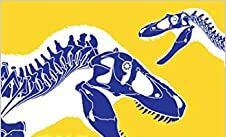Title: The Tyrannosaur Chronicles: The Biology of the Tyrant Dinosaurs
Author: Dr. David Hone
Publisher: Bloomsbury
Best for: Dinosaur enthusiasts age 15 and up

The Tyrannosaur Chronicles is part of Bloomsbury’s Sigma Series titles. It is written for a popular science audience.
Just as the fruit fly Drosophila melanogaster is the central base for genetics research, the frog Xenopus laevis for neurology, and the small roundworm Caenorhabditis elegans for developmental biology, Tyrannosaurus is a fundamental base for much dinosaur research.
This book is suitable for anyone who wants to learn more about dinosaur paleontology, especially if you are drawn to tyrannosaurs. The book is kept deliberately general in tone. Dr. Hone does a good job of sharing his expert knowledge without getting bogged down citing scientific papers (there are more than 1,500 on tyrannosaurs alone) or using technical jargon.
Accompanied by clear, informative illustrations (by Scott Hartman), the book provides an excellent introduction to dinosaurs generally and tyrannosaurs specifically. Discussions of anatomy, growth, metabolism, feathers, behavior, prey, competitors, and the ecology of tyrannosaurs over the millions of years this group existed are some of the major topics covered.
For a dinosaur enthusiast, I highly recommended The Tyrannosaur Chronicles: The Biology of the Tyrant Dinosaurs.
Inside the Book
The book is divided into four major parts, each covering logically associated topics in individual chapters.
David Hone and Scott Hartman included an outstanding primer with excellent anatomical illustrations for Tyrannosaurus. In fact, it could easily serve as a general introduction to basic dinosaur anatomy.
Part 1: Introduction (Chapters: “Introducing the Dinosaurs,” “What is a Tyrannosaur?”, “Tyrannosaur Species,” “Tyrannosaur Relationships,” “Tyrants in Time and Space”)
Given that the tyrannosaurs were around for almost 100 million years (approximately 160 to 66 million years ago), discussing how they developed and where they lived during this period definitely deserves a chapter. As Dr. Hone points out, the famous Tyrannosaurus rex we’ve all heard of had much smaller ancestors that possibly emerged as early as 190 million years ago.
Part 2: Morphology (Chapters: “Skull,” “Body,” “Limbs,” “Outside,” “Physiology,” “Changes”)
As you might expect, there are many anatomical diagrams in this section of The Tyrannosaur Chronicles: The Biology of the Tyrant Dinosaurs, but returning occasionally to the primer will be helpful when reading the text. What I did not expect, but was pleased to find, is how well specific information—such as the digestive tract of Scipionyx, a fossil of which resides in the Natural History Museum in Milan, Italy—is woven into the text without going into excessive detail. Yes, the tiny arms are discussed in the “Limbs” chapter, but perhaps readers will be more interested in the feathered tyrannosaurs discussed in “Outside.” The “Changes” chapter has a particularly well done illustration of skulls from different tyrannosaurs, helping to visualize their development over time.
Part 3: Ecology (Chapters: “Reproduction and Growth,” “Prey,” “Competitors,” “Obtaining Food,” “Behaviour and Ecology”)
It’s quite amazing to see just how much the fossil record can tell us about tyrannosaurs. There’s an impressive growth chart of several species. Even more impressive is a discussion of sexual signals (which in modern animals include bright colors on male birds, manes on male lions, and large antlers on male deer) and competition. Early tyrannosaurs had crests used for sexual display and social rank. Later tyrannosaurs bit each other’s faces, possibly in competition for mates. The discussions in “Prey,” “Competitors,” and “Obtaining Food” were valuable for putting tyrannosaurs back into the context of the environment they lived in. It’s easy to think that as the dominant predator, Tyrannosaurus rex ate anything it felt like, whenever it felt like it, but the truth was far different.
Part 4: The Future (Chapters: “Tyrannosaurus Fact and Fiction,” “The Future,” “Conclusions”)
There is an interesting discussion about reevaluating fossils in collections, which may not actually be separate species, but rather represent juvenile tyrannosaurs. Looking ahead, Dr. Hone makes some safe extrapolations of finds we can expect based on general biological principles and similar dinosaurs. An especially interesting question he raises is this: Why have almost all tyrannosaur fossils been found in the northern hemisphere? Shouldn’t a rich fossil bed like the Tendaguru in Tanzania have similar fossils to the ones from the Morrison Formation in Wyoming? We certainly can hope tyrannosaur fossils will be found in these rich Southern Hemisphere locations! Be sure to check out Dr. Hone’s “Further Reading” note with five excellent references, because as he says, “Diving into the literature can be difficult.”
About Dr. David Hone
David Hone is a lecturer in zoology at Queen Mary University of London. He has published more than 50 academic papers on dinosaur biology and behaviour, with tyrannosaurs being of particular research interest, and his fieldwork has included some time on the famous Chinese deposits. David’s writing credits include a regular blog for the Guardian and the BBC’s Walking with Dinosaurs website. He has appeared on the Discovery Channel, BBC Radio 5 Live, and RTE; acted as a consultant for National Geographic documentaries; and written articles for New Scientist, the Times, the Independent, the Telegraph, the New York Times, Science Connected, and many other publications.
RELATED: MOUNTING A MONUMENT TO MESOZOIC MONSTER




